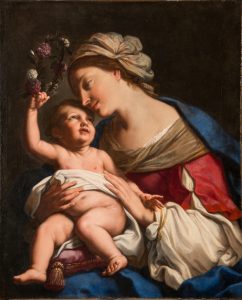This is the third in a four-part series BNG will publish every Monday during Advent.
I, like many of you, was in at least one Christmas pageant as a child growing up in the Baptist church. Sadly, I can distinctly remember I was not chosen to play the Virgin Mary. I was an angel.
If truth be told, my biggest problem was that my quieter younger sister was chosen to play Mary. She was the obvious choice, much better behaved than me, I will admit. The rest of us wore bathrobes or white choir or baptismal robes, but Mary had a beautiful light blue costume. I can remember feeling jealous. Maybe this influenced my interest in Mary, the mother of Jesus, or perhaps it’s just the convenient memory of childhood. Whatever may be true of my patchy memory from 35 odd years ago, I wanted to be Mary.

Julia Goldie Day
I don’t think we are accurate in portraying Mary as the silent and compliant type. She is typically portrayed as meek and mild — silent even in our pageants — only speaking her infamous words, “Let it be,” and nodding acquiesce to the angel delivering the good news.
How quickly we forget how much Mary had to say.
It makes sense that we have celebrated in dramatic form the coming of Jesus as a baby born of a woman, Mary, because the first chapters of the Gospel of Luke may have been designed for that very purpose. Some have said Luke’s telling of the events that led to the manger contain many literary devices describing movement, such as “the angel departed from her,” as evidence of a dramatic play the early church may have performed. It’s an interesting supposition — it’s fun to imagine early Christians acting out this story as we have so often done.
However, we must ask ourselves, are we representing in our pageants and our worship the Mary found in the Gospel, or are we representing what our culture has influenced us to have her be?
Not so meek and mild
Mary was not silent. Mary was brave enough to ask an angel a question. Remember how people usually act when angels show up in Scripture? Afraid, hence the greeting, “Fear not!” Mary didn’t wait for men to act and then follow their lead. She acted, traveling to see her family member Elizabeth while pregnant, and then singing her song which could not possibly be described as meek and mild.
“Mary was not silent. Mary was brave enough to ask an angel a question.”
Mary also wasn’t white or in the ethnic majority as we often see her portrayed. We don’t know her age, but many have guessed she would have been fairly young since she was in the engagement period with her husband to be, Joseph. What we do know is that Mary was old enough to speak for herself, travel at her own will and make her own decisions, so probably not an immature, young teenager.
So if Mary isn’t described as meek, mild or silent, how is she described? Mary is described as a virgin in Luke’s Gospel. The description of virgin comes first in our translated-to-English Bibles and then we are told her name — Mary. Baptists don’t often utilize the title “Virgin Mary” that most have given her but I’m not sure why. Maybe because it sounds like there might have been another Mary that wasn’t a virgin? Or perhaps we are more comfortable not saying the virgin part out loud.
About the virginity part
Do we believe it is very important, the virginity part? Oh yes. Virginity is important, or at least that’s what we were told. As a part of my Baptist upbringing there was great emphasis on remaining pure and a virgin until marriage. This is God’s plan for your life, especially for young women.
My problem with this message is we seem to believe women must live up to the impossible standard of the Virgin Mary, a mother and yet somehow free from the taint of sexual activity. Also, don’t talk too much or have any questions about how this is going to work!
“The word ‘virgin’ may not mean what we think it means.”
The word “virgin” may not mean what we think it means. In her article “No More Lying About Mary,” Nancy Rockwell says, “The Greek word Luke uses for ‘virgin’ is an unusual one, a very specific word that means she has not yet born a child. Its precise meaning does not indicate sexual innocence. So let’s be clear: The focus is on her uterus. The state of her hymen is not at issue here.”
The value in virginity is perhaps descriptive for the miraculous nature of the birth of Jesus and not any sexual status or category. To put it plainly, Mary could have been a virgin and conceived with the help of the Holy Spirit without a man, or Mary could have not been a virgin and conceived with the help of the Holy Spirit without a man. Both would be a miracle.

“Virgin and Child,” Elisabetta Sirani, 1663. National Museum of Women in the Arts.
The earliest dating of Scripture detailing the birth of Jesus comes not from the Gospels but from Galatians 4:4-5, “But when the fullness of time had come, God sent his Son, born of a woman, born under the law, in order to redeem those who were under the law, so that we might receive adoption as children.” These are likely the first words describing the birth of Jesus to be written and preserved in Scripture from the early church.
Born of a woman. Human born. Not virgin born.
Many scholars have spent countless words arguing over the translation of this one little word from Luke’s first chapter in one of the most important stories told in the New Testament; for me to attempt to summarize all the arguments would be a waste of our time. Many experts are convinced of their conclusions. Perhaps we can admit to ourselves that there is no way to know for certain.
Either way, I choose to believe it was possible for Mary to conceive her son as a virgin, because as the angel said, “Nothing is impossible for God.” Which we know because Mary wasn’t meek and silent; she had some questions!
More importantly, what we can believe is that Mary offers us a new option for purity.
It is important to note that in Luke’s Gospel, purity does not equal virginity. “They are not denigrating sex, women, conception or birth,” says scholar N.T. Wright.
What we do know with certainty is that this is a remarkable story of a remarkable young woman. This woman and her son Jesus will have an indelible role in bringing God’s kin’dom into being in the world. Mary is the first to know God’s amazing plans, the first to believe and accept the invitation to join the party.
Listen to Mary
What’s more to learn about Mary? There’s much more Mary describes about herself. We have just failed to listen. In Luke 1:46-49:
And Mary said,
“My soul magnifies the Lord,
and my spirit rejoices in God my Savior,
for he has looked with favor on the lowly state of his servant.
Surely from now on all generations will call me blessed,
for the Mighty One has done great things for me,
and holy is his name.”
Mary refers to herself as the servant or handmaiden of the Lord, “which in Greek means ‘(female) slave,’ indicating that Mary’s self-designation is one of ‘both personal freedom and complete devotion. … This epithet also associates Mary with celebrated fellow ‘slaves of the Lord’ or ‘servants’” such as Moses, David and Paul. Mary is God’s servant, willing to take on a role of great importance. “The only master Mary has is God,” say Amy-Jill Levine and Ben Witherington in their joint work The Gospel of Luke.
Mary is God’s lowly servant. “Lowly” is a term that carries a social connotation in the time of Mary and today. Sharon H. Ringe writes that “one was ‘lowly’ in the sense of ‘humiliated’ or ‘marginalized’ because of one’s failure to live up to the demands of honor and respectability that characterize a society such as that into which Jesus and John were born. The word could be used, for example, of a woman like Elizabeth who was unable to conceive a child, or it could be used of a woman who had been raped.”
“Mary speaks with power from a place of weakness.”
Luke is communicating that “lowly” at the very least signifies that Mary identifies with “such despised women.” Lowly (and despised) yet favored and blessed by God, the mother of God, first disciple and prophet, Mary speaks with power from a place of weakness, illustrating with her very life the amazing things that God has and will do in kin’dom work.
Mary’s body was not inherently sinful, despite whatever her sexual status may have been, nor are the bodies of any women sinful. Like Mary, women outside of the so called “sexual norm” are honored in the gospel story. Tamar, Rahab, Ruth and Bathsheba, the four women included in the genealogy of Jesus in the Gospel of Matthew, each have compromising sexual status. God actively chose to achieve divine purposes through all these women.
Purity is not defined as virginity in Scripture. And of course, men never were judged for their virginity, so why should women be?
Let us not allow our preconceptions of women, bodies and purity to somehow lessen the powerful role of Mary in the Gospel story. May we be brave in lifting the voice and leadership of blessed Mary and blessed women. How will we embrace a new vision of purity — not virginity — that honors the strong, brave and faithful women in the Scriptures and in our own lives and churches?
“Blessed are the pure in heart, for they will see God,” says Jesus in Matthew 5:8. We are whole, we are good, and God is with us.
May we see God through women. May women see God in themselves.
For consideration
A few practical suggestions to consider:
- Read Expecting Emmanuel: Eight Women Who Prepared the Way by Joanna Harader. This delightful Advent devotional centers the telling of the Gospel story through the faithful women who made it all possible. Remember that many of these women all have a common thread — they are outside the sexual norm.
- Examine how you teach members of your family or your church about faithful and healthy sexuality. Are you falling for the lie and shame of “purity culture” that the evangelical church tends to promote? Or are you teaching young people and the entire church about consent, mutuality, healthy boundaries and the skill of decision making in living out core values that are instilled by our faith?
- Listen to Maddie Zahm’s song, “You Might Not Like Her.” In this song, the artist acknowledges that everyone might not like her but she loves herself. When we raise our daughters to love themselves, the bodies they are in and to love Jesus, we must be careful of the messages we send. Many women around my age and older are still healing from the toxicity of purity culture. Many men still think they can judge us for our bodies or sexuality; however, Mary can teach us a better way.
- Examine your church policies. How do you prevent sexual abuse or harassment in your church? Do you have a clear, formalized plan for abuse reporting to church leadership and to law enforcement? Do you describe appropriate and inappropriate behavior? If you have some sort of policy in place, ask if it is being followed. What group in your church body is responsible for monitoring these important procedures to maintain accountability? (This cannot fall entirely to ministerial staff as that often results in under reporting). Lay leaders and ordained leaders must work together to create a safe space for women and others with less power. In other words, if you aren’t actively working on this, you aren’t providing safe and healthy environments. Resist the urge to pat yourself on the back for having a female ministerial staff member or an abuse prevention policy — delve deeper and ask the hard questions that can lead to change. Each church member is responsible as we work together to follow Jesus. Not knowing doesn’t excuse abuse. For this important work, it may be helpful to utilize resources from Baptist Women in Ministry and CBF.
Julia Goldie Day is ordained through the Cooperative Baptist Fellowship and lives in Memphis, Tenn. She is a painter and proud mother to Jasper, Barak and Jillian. Learn more at her website.
Related articles:
Mary, Our Mother (for Baptists): There’s something about Mary | Opinion by Julia Goldie Day
Mary, Our Mother (for Baptists): Mary, did you know? | Opinion by Julia Goldie Day


